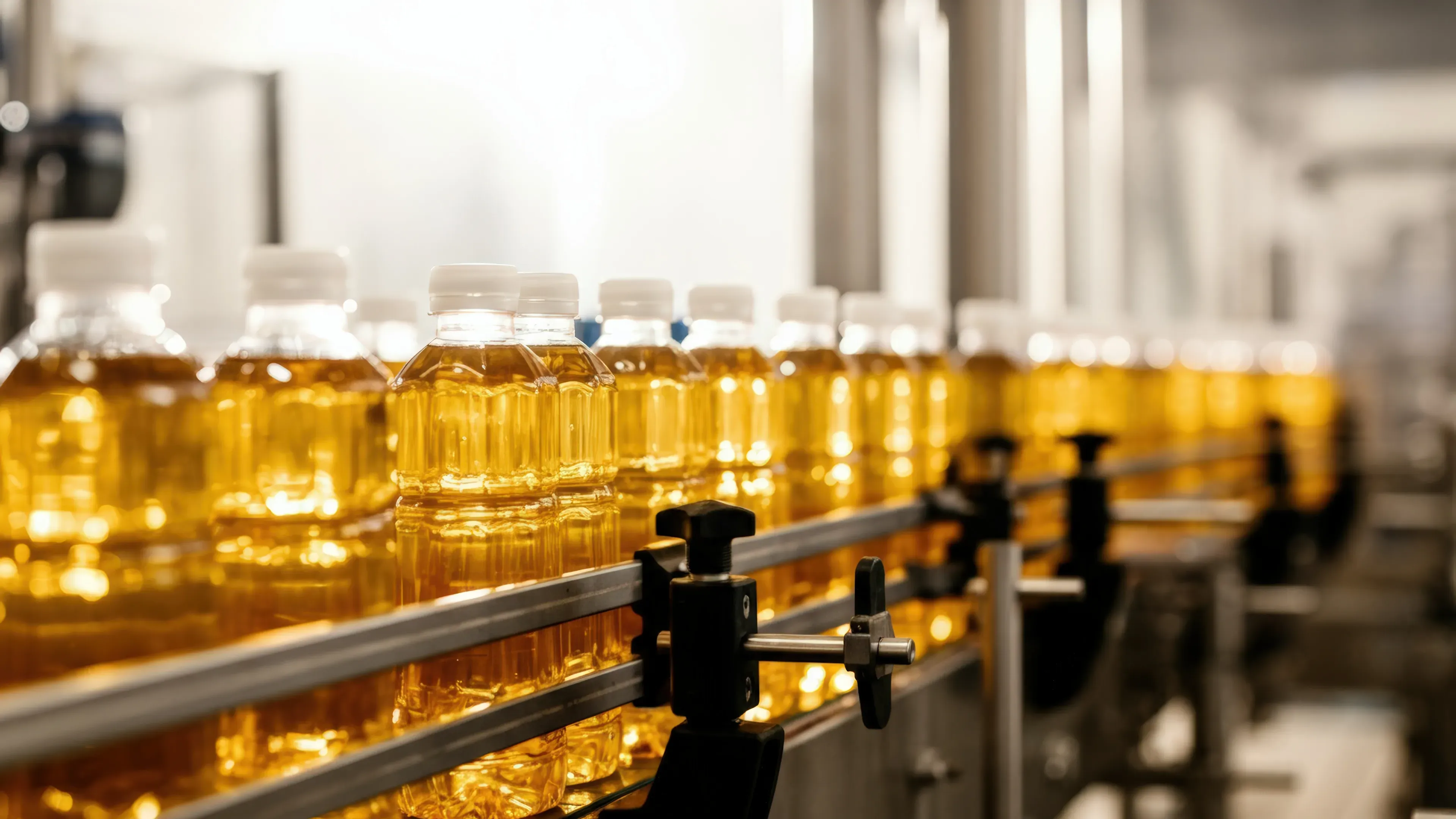
MOSH/MOAH-Analytik:
Mineralölrückstände in verschiedenen Lebensmitteln sicher und effizient bestimmen
Legislation requires that foodstuffs be tested for harmful mineral oil residues. Particular attention is paid to vegetable oils and -fats, but other foodstuffs are also coming into focus. We examine how it is done.
Analysis overview: The extraction of mineral oil hydrocarbons (MOSH/MOAH) from foodstuffs involves several steps: Simply put, except for most aqueous or edible oil samples, the food must be homogenized to ensure uniform distribution of the analytes, enabling representative sampling. The MOSH and MOAH compounds are then extracted from the sample using n-hexane. Efficient extraction generally requires shaking or stirring. This is followed by liquid chromatographic separation of MOSH and MOAH using normal-phase (NP) high-performance liquid chromatography (HPLC) on silica gel and a solvent gradient (n-hexane/dichloromethane [DCM]), followed by gas chromatography with flame ionization detection (GC-FID). The data from the GC-FID determination are analyzed, and the concentrations of MOSH and MOAH in the sample are calculated using internal standards [1].
Not Just for Vegetable Oils and Fats: To expand the spectrum of MOSH/MOAH determination, we tested various foods for possible contamination with mineral oil residues, including palm oil, dried instant noodles, seasoning oils, and various spices such as cumin [1-3]. For the MOSH/MOAH analysis, a 1260 Infinity II HPLC system (Agilent® Technologies) was used. The system was coupled via an LC-GC interface to a dual-channel GC-FID system (GC 8890, Agilent® Technologies) specially modified for simultaneous determination of the MOSH and MOAH fractions. The GC was equipped with an early vapor exit (EVE, GERSTEL) for evaporating the solvent from the HPLC before the start of the GC analysis, a MultiPurpose Sampler (MPS, GERSTEL) was used for sample introduction. A separate MultiPurpose Sampler workstation (MPS roboticPro), equipped with various modules for sample extraction, agitation, incubation, centrifugation, and evaporation was used for automated sample preparation, from saponification, extraction, and concentration to epoxidation of the sample extract.
Key Steps: To separate the MOSH and MOAH fractions and remove interfering matrix compounds, such as triglycerides, HPLC was performed in normal-phase mode on a silica column. A 450 µL sample of each fraction was taken using a special 9-port selection valve, which transferred these into the uncoated guard columns of the front (MOSH) and rear (MOAH) channels of the GC, respectively. After the transfer, the LC column was backflushed during the GC run. The solvent was evaporated in the guard column and removed via the Early Vapor Exit (EVE). The analytes of each fraction were focused in their respective guard column before being separated in the analytical column and detected using FID. Quantification was performed based on the relative areas of the MOSH and MOAH signals compared with internal standards. Data analysis and reporting was performed automatically using a dedicated MOSH/MOAH data analysis software (ChroMOH, GERSTEL), including signal correction in compliance with standard methods. Individual molecular size ranges were separately color coded and quantified for simplified interpretation.
MOSH/MOAH in Palm oil: Two grams of palm oil were manually diluted in 10 mL of hexane and spiked with 10 µL of an internal standard. One mL of the resulting extract was epoxidized at 65 °C for 30 minutes according to DIN 20122 (Appendix C) [1]. The palm oil samples contained relatively high concentrations of MOSH and MOAH: 18.3 and 6.2 mg/kg in sample 1, and 19.3 and 6.0 mg/kg in sample 2, respectively.
MOSH/MOAH in Instant Noodles: Instant noodles were tested for MOSH/MOAH using the same method. Comparison with the palm oil test revealed no deviations from the standard method for vegetable oils, except the need for an increased sample size (2 g for palm oil and 5 g for noodles). The noodles appeared to contain MOSH/MOAH contamination from different sources and origins: The resulting chromatograms show one very pronounced hump in approximately the 12 to 20 carbon atom range and another elongated hump in the 26 to >50 carbon atom range. The different shapes of the humps indicated the presence of contaminants from different sources.
MOSH/MOAH in Spice Oil: In contrast to pure vegetable oils obtained by pressing or extracting plant-based sources, vegetable oil-based spice oils contain a more complex matrix due to the addition of herbs, spices, or flavorings. Manual epoxidation was performed in accordance with a modified DIN EN 16995 method, and fully automated sample preparation was performed using saponification and epoxidation in accordance with DIN 20122. Interfering n-alkanes were removed from the MOSH fraction during the HPLC run using activated aluminum oxide (AlOx) [2]. Two humps are visible in one chromatogram, indicating contamination with mineral oil residues from more than one source. The chromatogram of another sample shows a size distribution in a larger hydrocarbon range with peak concentrations between 30 and 45 carbon atoms. The automated procedure offers significant time savings and increased efficiency.
MOSH/MOAH in Spice: Spices pose an analytical challenge. Their matrix is complex and they contain numerous natural aromatic compounds, pigments, and oils, complicating the determination of individual contaminants. The determination of MOSH/MOAH in spices is particularly challenging because the compounds may be present in low concentrations and could be masked by naturally occurring compounds. Dedicated sample preparation techniques are required along with sensitive analytical equipment. Various spices (cumin, cloves, nutmeg, oregano, and turmeric) were examined. The spices were ground, allowing smaller volatile compounds to evaporate. A 2.5 g sample of each specimen was manually extracted with 10 mL of hexane. The extracts then underwent automated sample preparation, comparable to the standardized procedure described above for palm oil. The samples were analyzed for the presence of potentially interfering volatile compounds. Automated saponification and epoxidation were performed in addition to online AlOx purification. Automated data analysis of the resulting chromatograms revealed contamination at 22.2 mg/kg MOSH and 0.8 mg/kg MOAH for the cumin sample analyzed.
Manual versus Automated Data Analysis: MOSH/MOAH chromatograms from the analysis of food, packaging, and personal care products differ significantly from conventional chromatograms and are difficult to interpret. Despite the chromatographic effort involved in MOSH/MOAH analysis, the hydrocarbons in these samples represent a complex mixture of mineral oil components that cannot be separated. This leads to a distribution of the compounds according to carbon number over a long retention time, but not to a separation into individual peaks, rather in the form of a "hump." Due to their plant origin, vegetable oils and food products containing oils and fats naturally contain many different compounds such as n-alkanes, terpenes, squalenes, or sterenes, which are not mineral oil contaminants. These compounds are located on top of the MOSH/MOAH humps and must be subtracted. Performing this work manually is labor- and time-intensive. Automated data processing is preferable as it allows for rapid and objective evaluation of complex MOSH/MOAH chromatograms. Manual data evaluation requires considerable experience and individual assessments by the analyst, leading to deviations between users. This risk can be eliminated by using a universal algorithm for automated integration. [4]
Conclusion: To test whether a standard method developed for vegetable oil is also suitable for the determination of MOSH/MOAH in other foods, various food matrices (palm oil, instant noodles, and cumin) were investigated. Result: Mineral oil contamination can be determined efficiently and reliably in various matrices with minimal manual effort using the fully integrated HPLC-GC-FID system presented here. No changes to the analysis method are required; only adjustments to sample preparation may be necessary. Automating the MOSH/MOAH determination offers the added value of simplification while simultaneously providing comparable and reproducible results from user to user. Software-supported data analysis reduces the number of potential sources of error and minimizes the amount of labor required.
References:
[1] Fully Automated Sample Preparation (ISO 20122) for MOSH/MOAH Determination in Seasoning Oils. AppBrief
https://www.gerstel.com/en/Publications/AppNote/food-beverages/AppBrief-19
[2] Determination of MOSH/MOAH in Palm Oil and Instant Noodles. AppBrief (2025).
https://www.gerstel.com/en/Publications/AppNote/food-beverages/AppBrief-20
[3] Easy automated data processing of complex MOSH/MOAH samples. (Details available upon request, expected availability under www.gerstel.com as of August 2025)
[4] MOSH/MOAH-Datenanalyse.
https://www.gerstel.com/en/products/Software-Data-Evaluation/chromoh
